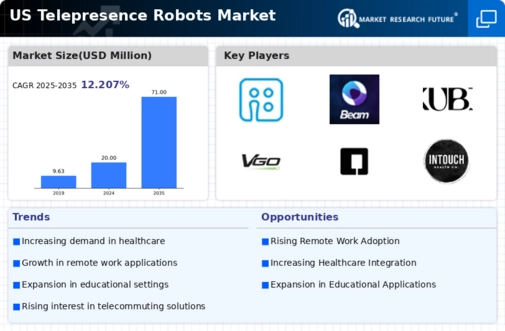Advancements in Robotics Technology
Technological advancements in robotics are significantly influencing the telepresence robots market. Innovations in mobility, sensor technology, and artificial intelligence are enhancing the capabilities of telepresence robots, making them more user-friendly and efficient. For instance, the integration of advanced cameras and microphones allows for high-quality audio-visual experiences, which are crucial for effective communication. Furthermore, the development of autonomous navigation systems enables robots to move freely within environments, thereby increasing their utility in various settings. The telepresence robots market is likely to benefit from these advancements, as they not only improve user experience but also expand the potential applications of telepresence robots across different sectors, including healthcare, education, and corporate environments.
Focus on Accessibility and Inclusivity
The telepresence robots market is increasingly focusing on accessibility and inclusivity, driven by a growing awareness of the need to accommodate diverse user needs. Organizations are recognizing the importance of providing equal opportunities for individuals with disabilities or those who may be unable to travel. Telepresence robots offer a unique solution, enabling remote participation in meetings, events, and educational settings. This focus on inclusivity is not only a moral imperative but also a business strategy, as companies that prioritize accessibility can tap into a broader customer base. The telepresence robots market is thus likely to expand as more organizations adopt these technologies to foster inclusive environments, ultimately enhancing their reputation and market reach.
Rising Need for Enhanced Customer Engagement
The telepresence robots market is increasingly driven by the rising need for enhanced customer engagement across various industries. Businesses are recognizing that personalized interactions can significantly improve customer satisfaction and loyalty. Telepresence robots facilitate face-to-face communication, allowing companies to connect with clients in a more meaningful way, regardless of geographical barriers. This trend is particularly evident in sectors such as retail and hospitality, where customer experience is paramount. As organizations strive to differentiate themselves in competitive markets, the telepresence robots market is likely to see a surge in demand for solutions that enhance customer interactions, ultimately leading to improved business outcomes.
Growing Demand for Remote Communication Solutions
The telepresence robots market is experiencing a notable surge in demand for remote communication solutions. As organizations increasingly prioritize effective communication across distances, telepresence robots offer a viable alternative to traditional video conferencing tools. This shift is particularly evident in sectors such as education and corporate environments, where the need for seamless interaction is paramount. According to recent data, the market is projected to grow at a CAGR of approximately 15% over the next five years, driven by the desire for enhanced collaboration and engagement. The telepresence robots market is thus positioned to capitalize on this trend, providing innovative solutions that facilitate real-time communication and interaction, ultimately enhancing productivity and connectivity among teams.
Increased Investment in Telecommuting Technologies
The telepresence robots market is witnessing increased investment in telecommuting technologies, reflecting a broader trend towards remote work solutions. Companies are allocating substantial budgets to enhance their remote working capabilities, recognizing the importance of maintaining productivity and collaboration in a distributed workforce. This investment is expected to drive the adoption of telepresence robots, which provide a more immersive experience compared to traditional communication tools. Recent estimates suggest that the market could reach a valuation of $1 billion by 2027, as organizations seek to leverage technology to bridge the gap between remote and in-office employees. The telepresence robots market stands to gain significantly from this influx of capital, enabling further innovation and development of advanced telepresence solutions.
















Leave a Comment